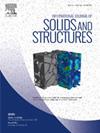Nonlinear static analysis of metamaterial structures based on the Kagome lattice using beam finite elements and component-wise approach
IF 3.4
3区 工程技术
Q1 MECHANICS
International Journal of Solids and Structures
Pub Date : 2025-05-06
DOI:10.1016/j.ijsolstr.2025.113387
引用次数: 0
Abstract
This work numerically investigates the mechanical behavior of metamaterial structures inspired by the Kagome lattice mechanism using the Carrera Unified Formulation (CUF). The proposed numerical model employs enhanced one-dimensional finite elements with three-dimensional capabilities, enabling precise predictions of deformation patterns and stress–strain responses under various loading conditions. With CUF, any three-dimensional effects can be captured, allowing for the analysis of the width direction of these metamaterial structures, potentially accounting for varying geometric properties. The model’s robustness is demonstrated through its ability to capture critical phenomena such as buckling, post-buckling behavior, and rigid-body rotations of lattice triangles, which are hallmarks of the Kagome lattice’s unique mechanical properties. The introduction of stiffer hinges highlights the potential for tailoring mechanical responses to meet specific design requirements, such as enhanced load-carrying capacity and optimized energy absorption. This study demonstrates the versatility of Kagome lattice-based metamaterials and lays the groundwork for future research, including the analysis of 3D Kagome-lattice metamaterials facilitated to the proposed numerical model.
基于Kagome点阵的超材料结构非线性静力分析
本文采用卡雷拉统一公式(Carrera Unified formula, CUF)对受Kagome晶格机制启发的超材料结构的力学行为进行了数值研究。所提出的数值模型采用具有三维能力的增强一维有限元,能够精确预测各种加载条件下的变形模式和应力-应变响应。使用CUF,可以捕获任何三维效果,允许分析这些超材料结构的宽度方向,潜在地解释不同的几何特性。该模型的稳健性通过其捕获关键现象的能力得到证明,例如屈曲、后屈曲行为和晶格三角形的刚体旋转,这些都是Kagome晶格独特力学性能的标志。更硬铰链的引入凸显了定制机械响应以满足特定设计要求的潜力,例如增强的承载能力和优化的能量吸收。该研究证明了Kagome晶格基超材料的多功能性,并为未来的研究奠定了基础,包括对三维Kagome晶格超材料的分析,为所提出的数值模型提供了便利。
本文章由计算机程序翻译,如有差异,请以英文原文为准。
求助全文
约1分钟内获得全文
求助全文
来源期刊
CiteScore
6.70
自引率
8.30%
发文量
405
审稿时长
70 days
期刊介绍:
The International Journal of Solids and Structures has as its objective the publication and dissemination of original research in Mechanics of Solids and Structures as a field of Applied Science and Engineering. It fosters thus the exchange of ideas among workers in different parts of the world and also among workers who emphasize different aspects of the foundations and applications of the field.
Standing as it does at the cross-roads of Materials Science, Life Sciences, Mathematics, Physics and Engineering Design, the Mechanics of Solids and Structures is experiencing considerable growth as a result of recent technological advances. The Journal, by providing an international medium of communication, is encouraging this growth and is encompassing all aspects of the field from the more classical problems of structural analysis to mechanics of solids continually interacting with other media and including fracture, flow, wave propagation, heat transfer, thermal effects in solids, optimum design methods, model analysis, structural topology and numerical techniques. Interest extends to both inorganic and organic solids and structures.

 求助内容:
求助内容: 应助结果提醒方式:
应助结果提醒方式:


